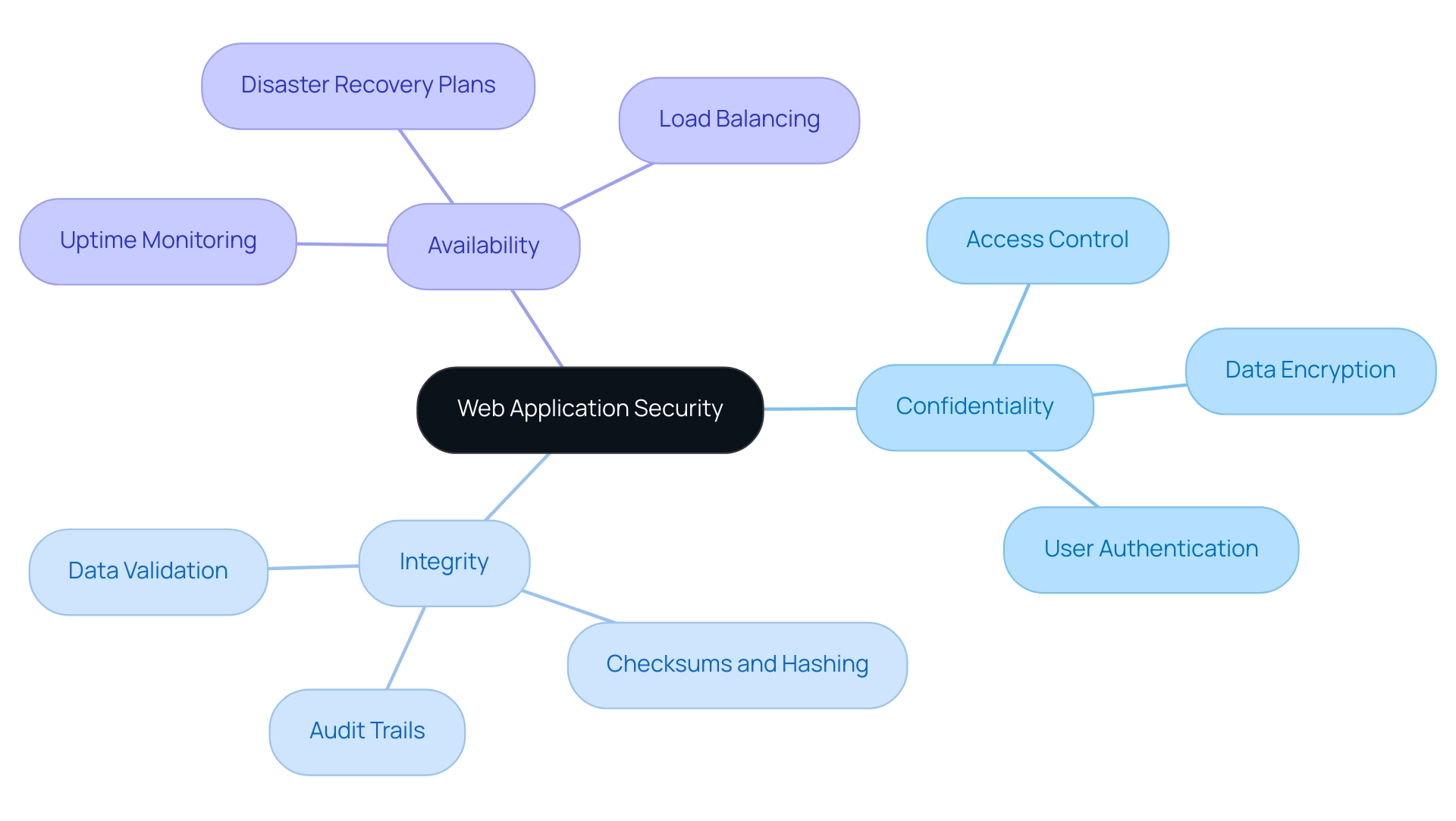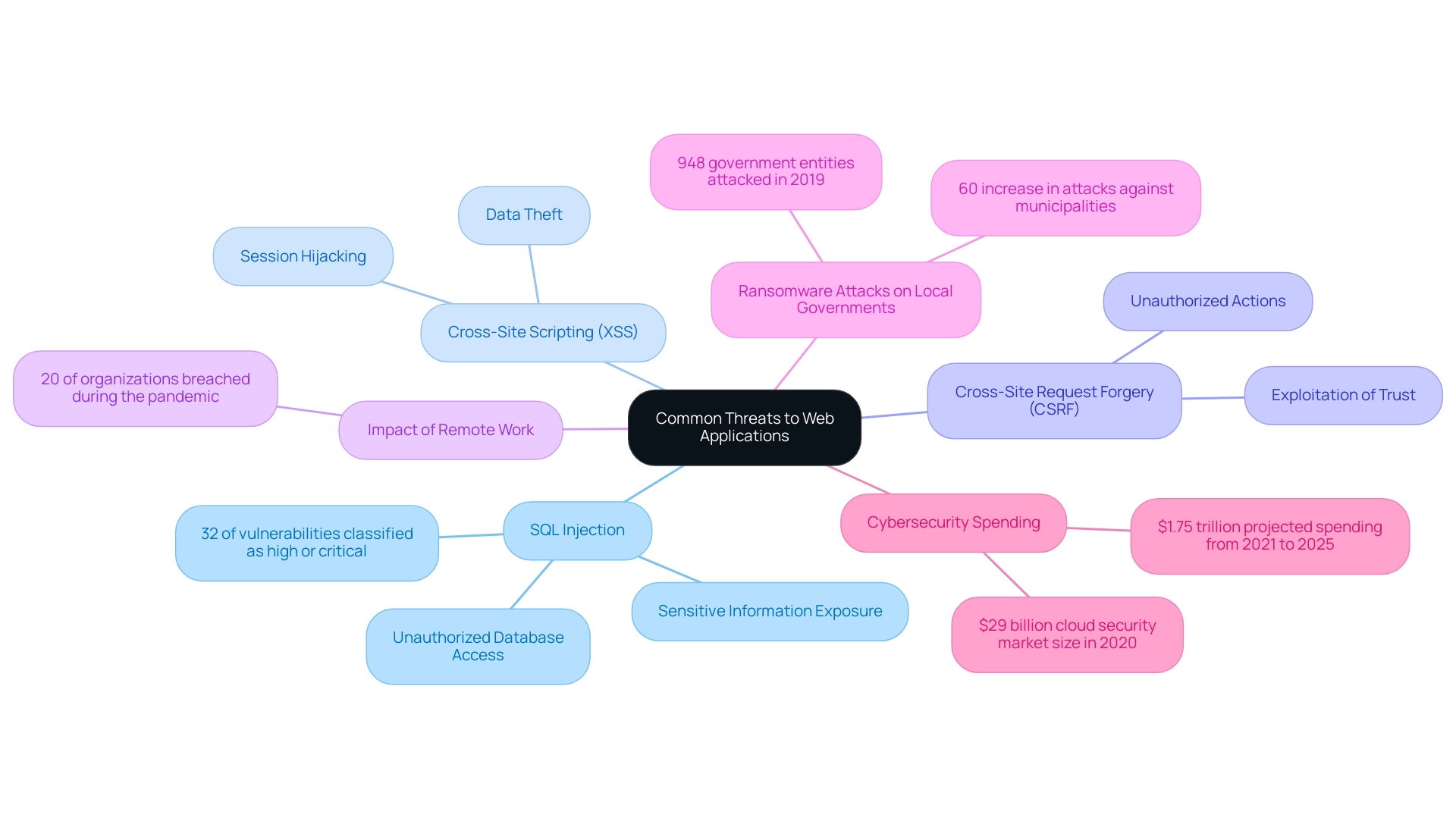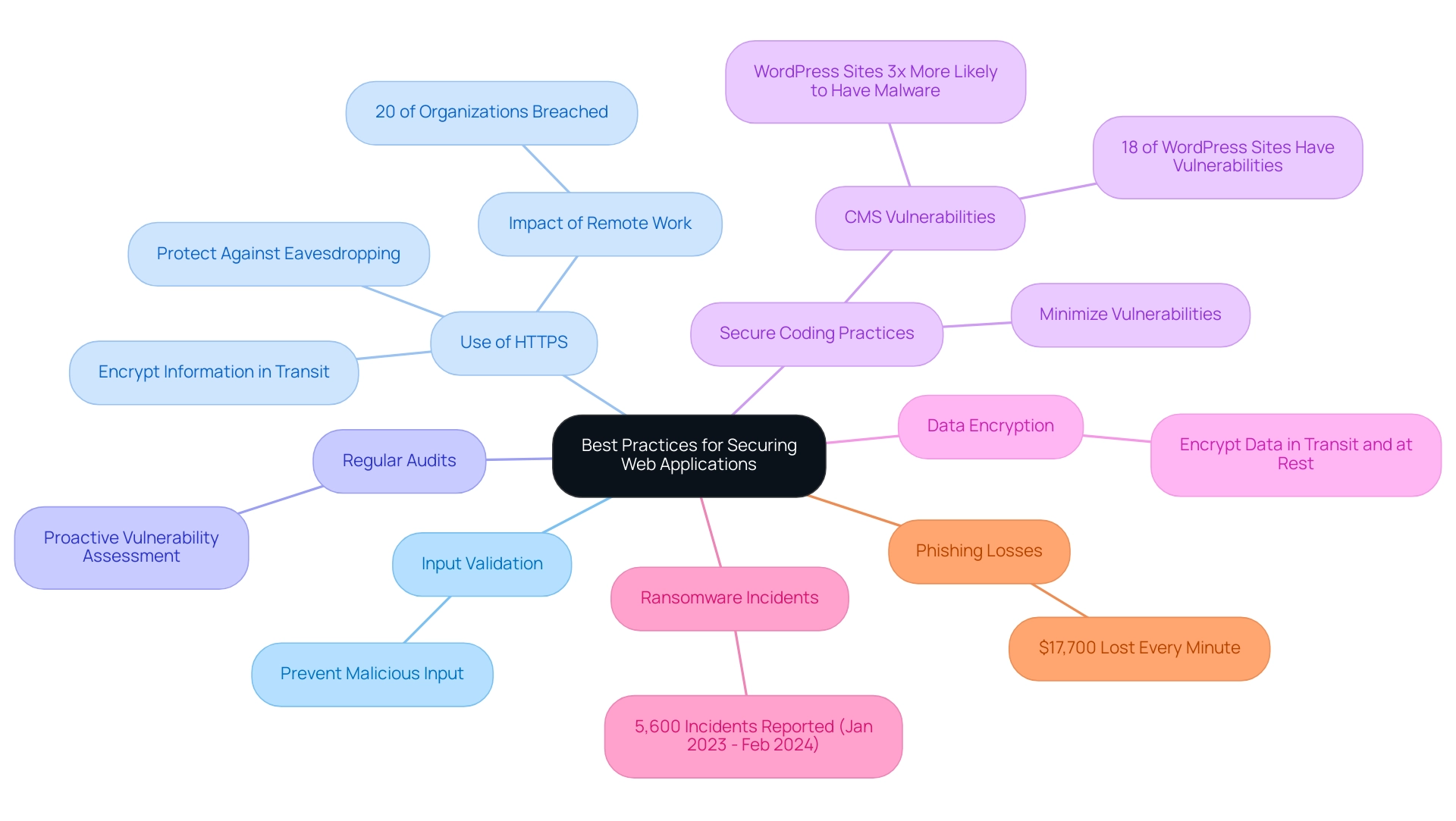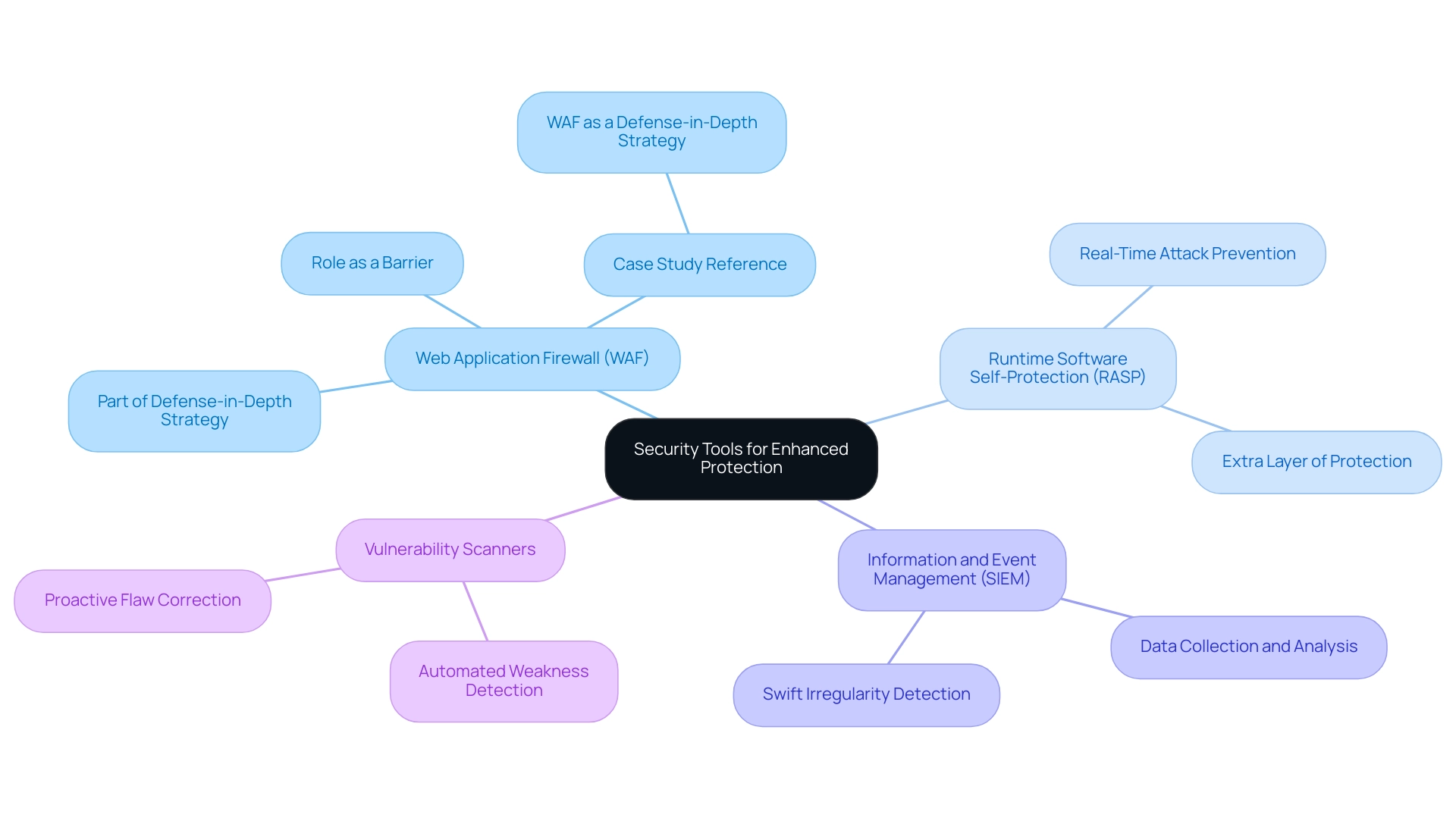Introduction
In an increasingly interconnected world, the security of web applications has emerged as a critical concern for organizations of all sizes. With cyber threats evolving at an alarming rate, understanding the foundational principles of web application security is essential for safeguarding sensitive data and maintaining user trust.
This article delves into the key concepts that underpin effective security strategies, identifies prevalent threats such as:
- SQL Injection
- Cross-Site Scripting
It also outlines best practices that can significantly enhance protection against malicious attacks. Furthermore, it highlights the importance of leveraging advanced security tools to create a robust defense mechanism.
As organizations navigate the complexities of the digital landscape, prioritizing web application security is not merely a precaution but a necessity for sustaining competitive advantage and ensuring operational continuity.
Understanding Web Application Security: Key Concepts and Importance
It is crucial to protect web applications in order to safeguard against a variety of threats that can lead to unauthorized access, information breaches, and other harmful activities. The fundamental ideas that support effective security strategies are:
- Confidentiality: This principle ensures that sensitive information is only accessible to authorized users, minimizing the risk of exposure.
- Integrity: Safeguarding data from unauthorized alterations or destruction is crucial for maintaining trust and reliability.
- Availability: Ensuring that web applications remain accessible and functional when needed is vital for user satisfaction and operational continuity.
Grasping these principles is vital, as they form the foundation of effective protective measures. Considering the recent statistic showing that remote employees have been involved in breaches in 20% of organizations during the pandemic, organizations must prioritize these concepts to protect web applications and safeguard user information while maintaining their reputation. The urgency of this need is underscored by the historical context of data breaches, which have been on the rise since the 1980s, particularly with the advent of cloud computing. Moreover, a strong protection framework is essential to protect web applications, aiding in compliance with legal standards and playing a significant role in enhancing customer trust and loyalty. As worldwide expenditure on cybersecurity products and services is anticipated to achieve an incredible $1.75 trillion cumulatively from 2021 to 2025, organizations are increasingly acknowledging that a robust protective stance is essential for sustaining competitive advantage and nurturing consumer trust.

Identifying Common Threats to Web Applications
Web platforms encounter a multitude of threats that can severely compromise security and user trust. Among these, SQL Injection remains a prominent concern. In this type of attack, malicious actors manipulate SQL queries to gain unauthorized access to databases, leading to the potential exposure of sensitive information.
The prevalence of such vulnerabilities is alarming, with 32% of vulnerabilities in internet-facing applications classified as high or critical, warranting immediate attention.
Equally concerning is Cross-Site Scripting (XSS), which allows attackers to inject harmful scripts into web pages that are subsequently viewed by unsuspecting users. This vulnerability can result in data theft or session hijacking, creating significant risks for both users and organizations. Recent trends suggest that as remote work environments become the norm, data breaches have surged.
According to Malwarebytes, "remote workers have caused a breach in 20 percent of organizations during the pandemic," highlighting the impact of this shift on vulnerabilities.
Another critical threat is Cross-Site Request Forgery (CSRF), which exploits the trust a web platform has in the user's browser. This type of attack can lead to unauthorized actions being performed on behalf of the user without their consent.
A stark reminder of the consequences of inadequate cybersecurity measures can be seen in the case of local governments, where at least 948 government entities in the U.S. were attacked by ransomware hackers in 2019, marking a 60% increase in attacks against municipalities. This trend underscores the urgent need for enhanced cybersecurity measures and resources to protect these entities.
Recognizing these threats is the first essential step in devising a strong strategy to protect web applications. Frequent evaluations and inspections are crucial to protect web applications by detecting current weaknesses within your web systems. With global spending on cybersecurity products and services projected to reach $1.75 trillion cumulatively from 2021 to 2025, it is imperative for organizations to stay vigilant and proactive in their defense mechanisms against these evolving threats.

Best Practices for Securing Your Web Application
To protect web applications, securing web platforms necessitates the adoption of robust best practices, especially given the alarming statistic that $17,700 is lost every minute due to phishing attacks. Malware and phishing are two of the most prevalent threat types currently hosted online, emphasizing the critical need for effective protective measures. Here are key recommendations to fortify your web applications:
- Input Validation: Rigorously validate all user inputs to prevent the processing of malicious information, which is essential for maintaining application integrity.
- Use of HTTPS: Implement HTTPS to encrypt information in transit, which serves to protect web applications from eavesdropping and unauthorized alterations. This is particularly vital as the shift towards remote work has exacerbated vulnerabilities; as noted by Malwarebytes, breaches have impacted 20% of organizations during the pandemic.
- Regular Audits: Schedule periodic assessments to uncover and address vulnerabilities proactively.
- Secure Coding Practices: Adhere to established secure coding guidelines to protect web applications by minimizing the introduction of vulnerabilities throughout the development lifecycle, particularly in the context of CMS platforms like WordPress, which are three times more likely to harbor malware.
- Data Encryption: Ensure that sensitive data is encrypted both in transit and at rest, safeguarding it from unauthorized access.
Additionally, with approximately 5,600 ransomware incidents reported between January 2023 and February 2024, the importance of these practices cannot be overstated. When these practices are seamlessly integrated into your development and operational workflows, they serve to protect web applications by creating a formidable barrier against a range of potential threats. In fact, 18% of WordPress sites contain at least one vulnerability, emphasizing the necessity of diligent plugin management and protective protocols.
By consistently implementing these best practices, you can greatly protect web applications and enhance your web platform's security in 2024 and beyond.

Leveraging Security Tools for Enhanced Protection
To improve the safety of your online services, it is essential to deploy a range of specialized tools:
-
Web Application Firewall (WAF): A WAF acts as an important barrier between your web service and the Internet, carefully monitoring and filtering HTTP traffic. By blocking harmful traffic and thwarting various types of attacks, it plays an essential role in protecting web applications, sensitive data, and maintaining system integrity. A recent case study titled 'WAF as a Defense-in-Depth Strategy' highlights that a WAF should not be the sole protective measure, as it lacks awareness of the backend system's context and can only block certain types of attacks. Thus, it should be part of a broader defense-in-depth strategy rather than a standalone solution.
-
Runtime Software Self-Protection (RASP): This innovative technology operates from within the software itself, detecting and preventing real-time attacks as they occur. RASP provides an extra layer of protection that conventional methods frequently disregard, effectively reducing risks linked to software vulnerabilities.
-
Information and Event Management (SIEM): SIEM solutions are essential for collecting and examining data related to safety across your entire infrastructure. Their capacity to swiftly identify irregularities and possible dangers allows response teams to act preemptively, greatly lowering the chances of successful assaults.
-
Vulnerability Scanners: These tools automatically examine your web platforms for known weaknesses, facilitating the proactive detection and correction of flaws. By routinely examining your software, you can stay ahead of potential dangers and uphold a strong protective stance.
Incorporating these tools into your strategy to protect web applications is not merely recommended; it is crucial for enhancing your web program's durability against a constantly changing array of cyber risks. Recent data indicates that the average cost of a data breach can vary significantly based on the level of automation, with estimates for 2024 suggesting that organizations with higher automation can save substantially compared to those relying on manual processes. Furthermore, as highlighted by industry expert paj28, 'a WAF alone cannot replace the need for addressing underlying application vulnerabilities,' reinforcing the argument for a multi-layered security approach.

Conclusion
Web application security is not just a technical requirement but a vital component of business integrity and customer trust. The foundational principles of confidentiality, integrity, and availability serve as the pillars of effective security strategies. By understanding and implementing these principles, organizations can significantly reduce the risks associated with unauthorized access and data breaches.
Identifying common threats such as:
- SQL Injection
- Cross-Site Scripting
- Cross-Site Request Forgery
is essential in crafting a robust security posture. The alarming statistics surrounding these vulnerabilities highlight the urgency for organizations to take proactive measures. Regular security assessments and audits are necessary to uncover weaknesses and bolster defenses against increasingly sophisticated cyber threats.
The adoption of best practices, including:
- Input validation
- HTTPS implementation
- Secure coding practices
cannot be overstated. These practices serve as the first line of defense against potential attacks, while advanced security tools like:
- Web Application Firewalls
- Runtime Application Self-Protection
- Security Information and Event Management systems
provide critical layers of protection. By integrating these tools into a comprehensive security strategy, organizations can enhance their resilience against evolving cyber threats.
In conclusion, prioritizing web application security is essential for any organization aiming to protect sensitive data and maintain operational continuity. As the digital landscape continues to evolve, the commitment to safeguarding web applications will not only ensure compliance with legal standards but also foster customer confidence and loyalty. The time to act is now; investing in robust security measures is not merely a choice but a necessity for sustaining competitive advantage in today's interconnected world.





